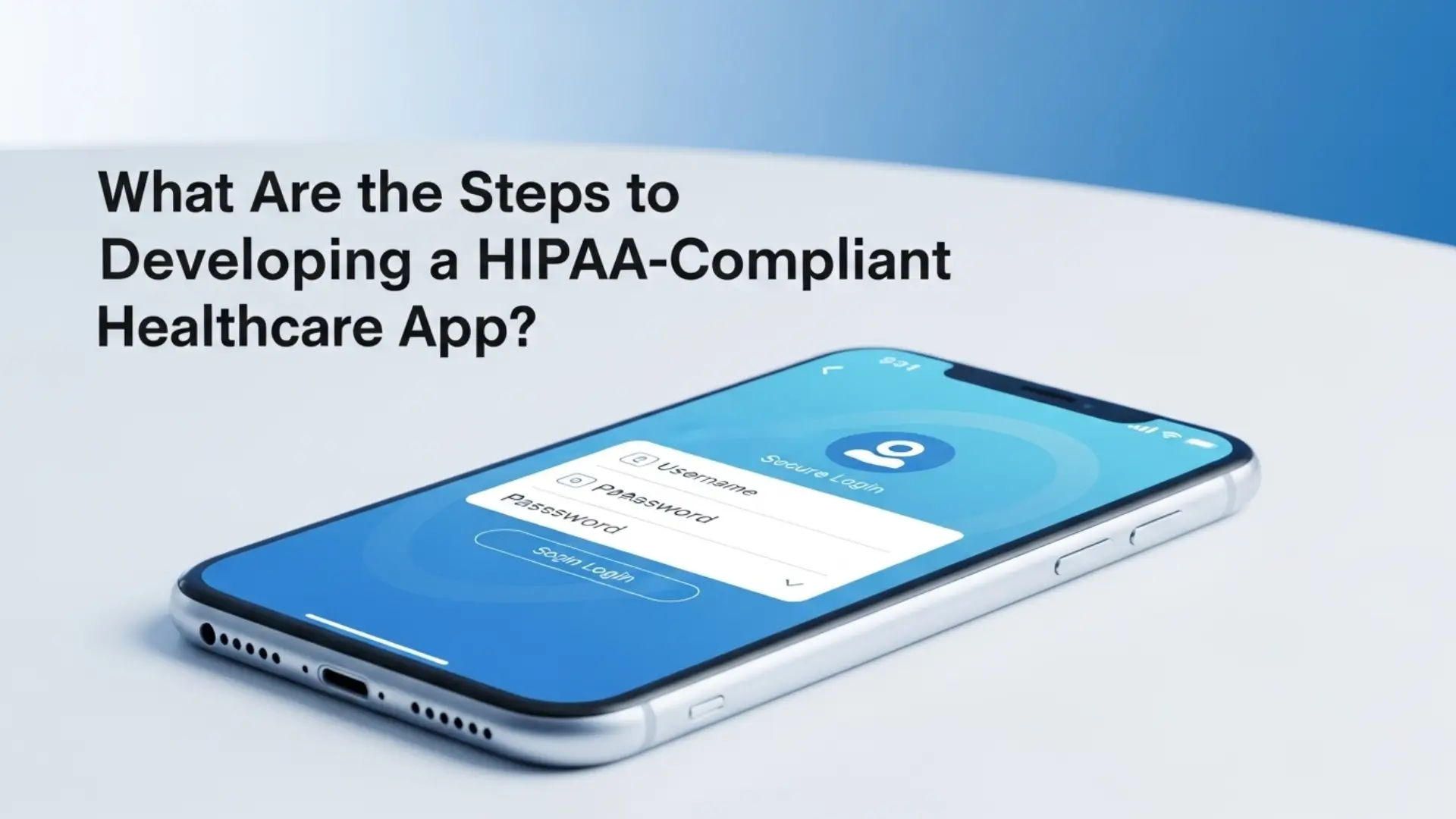In the digital age, healthcare is no longer confined to the walls of a hospital. Mobile health (mHealth) applications are revolutionizing how patients and providers interact, offering everything from remote patient monitoring to secure telemedicine consultations. However, this shift comes with a significant responsibility: protecting sensitive patient data. For any app that handles Protected Health Information (PHI), adherence to the Health Insurance Portability and Accountability Act (HIPAA) is not optional—it’s a legal and ethical imperative.
HIPAA compliance is often perceived as a daunting hurdle, a complex web of rules and regulations that can slow down innovation. But with a strategic, step-by-step approach, developers and businesses can build powerful, secure, and compliant healthcare apps that not only meet legal requirements but also build trust with their users. This comprehensive guide, crafted by an experienced enterprise software development company, breaks down the essential steps to developing a HIPAA-compliant healthcare app, providing a roadmap for success in the competitive mHealth market.
What is HIPAA and Who Must Comply?
Before writing a single line of code, it’s crucial to understand the core principles of HIPAA. The law, enacted in 1996, establishes national standards for the protection of sensitive patient health information. Its primary goal is to ensure the confidentiality, integrity, and availability of PHI.
HIPAA compliance applies to “Covered Entities” and “Business Associates.”
- Covered Entities: These are healthcare providers (hospitals, clinics, doctors), health plans (insurance companies), and healthcare clearinghouses.
- Business Associates: These are individuals or organizations that perform services for a Covered Entity and handle PHI. This includes cloud storage providers, billing companies, and, most importantly, the developers and hosting providers of your healthcare app.
If your app stores, transmits, or processes any PHI—which includes a patient’s name, medical records, lab results, social security number, or even an email address linked to their health information—you must comply with HIPAA regulations.
The 7-Step Blueprint for a HIPAA-Compliant Healthcare App
Developing a compliant app is a process that starts from the very beginning of the project, not as an afterthought. Here’s a detailed blueprint to guide you through each critical phase.
Step 1: Conduct a Thorough Risk Assessment and Privacy Analysis
This is the foundational step. Before you begin development, you must identify potential vulnerabilities where PHI could be at risk. a comprehensive risk assessment will:
- Identify all PHI: Pinpoint exactly what data your app will collect, store, and transmit. This includes data in transit (e.g., during a video consultation) and data at rest (e.g., stored on a server).
- Map data flows: Understand how PHI moves through your application, from user input to storage, and any third-party integrations.
- Analyze potential threats: Assess the likelihood and impact of various threats, such as data breaches, unauthorized access, or system failures.
- Document everything: Create a detailed report of your findings, which will serve as a crucial reference throughout the development lifecycle and for any future audits.
Simultaneously, you must develop a clear and concise privacy policy that explicitly outlines how your app will handle PHI, what rights users have over their data, and how it will be stored, used, and shared.
Step 2: Choose a HIPAA-Compliant Technology Stack and Hosting Provider
The tools you use are as important as the code you write. The architecture and technology stack must be built with security in mind from day one.
- HIPAA-Compliant Hosting: Your app’s backend and database must be hosted on a platform that is ready and willing to sign a Business Associate Agreement (BAA). Major cloud providers like AWS, Microsoft Azure, and Google Cloud offer specific HIPAA-compliant services. The BAA is a legal document that ensures the Business Associate (the cloud provider) will comply with HIPAA regulations.
- Secure APIs and Integrations: Any third-party service your app connects with—such as an electronic health records (EHR) system or a payment processor—must also be HIPAA-compliant. Ensure a BAA is in place with all such partners.
- Encryption Protocols: Use robust encryption protocols for both data in transit and at rest. For data in transit (e.g., when a user is interacting with the app), use TLS 1.2 or higher. For data at rest (e.g., stored in a database), implement a strong algorithm like AES-256.
Step 3: Implement Robust Technical Safeguards
The HIPAA Security Rule mandates specific technical safeguards to protect electronic PHI (ePHI). These are not just nice-to-have features; they are non-negotiable.
- Access Controls: Limit access to ePHI based on a user’s role and need. Use multi-factor authentication (MFA) to verify user identity before granting access. Implement automatic log-offs after periods of inactivity to prevent unauthorized access.
- Audit Controls: Your app must have a system for tracking all activity related to ePHI. This includes who accessed the data, when they accessed it, and what changes were made. These audit trails are essential for detecting and investigating potential security incidents.
- Data Integrity: Implement mechanisms to ensure ePHI is not improperly altered or destroyed. This can involve using checksums or other verification methods.
- Transmission Security: As mentioned in the previous step, all data transmission must be encrypted to protect against interception. This includes data sent between the app and the server, as well as any communications with third-party services.
Step 4: Design Secure and Intuitive User Experience (UX/UI)
A secure app must also be usable. A poorly designed interface can lead to user errors that compromise data security.
- Privacy by Design: Incorporate privacy into every aspect of your app’s design. This includes not displaying PHI on push notifications, masking sensitive data in user-facing fields, and providing clear, easy-to-understand consent forms.
- Clear Consent: Ensure that users explicitly consent to how their data will be used, and make it simple for them to review or revoke that consent at any time.
- Simple and Secure Workflows: Design workflows that minimize the chance of a user accidentally sharing or exposing PHI. For example, avoid auto-filling sensitive forms.
Step 5: Develop and Implement a Business Associate Agreement (BAA) Strategy
As previously mentioned, if your app is developed or maintained by a third-party, or if you use any cloud services, you will need a BAA. This agreement is a legal contract that obligates the Business Associate to protect PHI in accordance with HIPAA. Your BAA strategy should include:
- Identifying all Business Associates: Make a comprehensive list of every company or individual that will have access to PHI on your behalf.
- Reviewing and Signing BAAs: Work with legal counsel to draft or review BAAs with all your associates, ensuring they are legally sound and cover all necessary clauses.
- Periodic Review: Regularly review your relationships and BAAs to ensure they remain current and compliant.
Step 6: Rigorous Testing and Auditing
Security is an ongoing process, not a one-time task. Before launching your app, you must conduct a series of tests to validate its security posture.
- Penetration Testing: Hire a third-party security firm to perform penetration testing, which simulates a cyberattack to identify vulnerabilities.
- Vulnerability Scanning: Use automated tools to regularly scan your app for known security flaws.
- Code Audits: Conduct a thorough review of your app’s code to ensure it follows secure coding best practices.
- Compliance Audits: Engage with compliance experts to perform a formal audit of your app against HIPAA regulations. While there is no official HIPAA certification, a third-party audit demonstrates due diligence.
Step 7: Post-Launch Monitoring and Incident Response
Compliance doesn’t end at launch. You must have a plan for continuous monitoring and a robust incident response strategy. This is a critical part of the ongoing support for any custom software development services.
- Continuous Monitoring: Use logging and monitoring tools to track all user and system activity, and set up alerts for suspicious behavior.
- Breach Notification Plan: Have a clear, documented plan in place for what to do in the event of a data breach, including who to notify (users, the Department of Health and Human Services) and within what timeframe.
- Regular Updates and Patches: Stay on top of security updates for all libraries, frameworks, and operating systems your app uses. Proactively patch vulnerabilities as they are discovered.
- Employee Training: Ensure all personnel who handle PHI receive regular training on HIPAA regulations and your company’s security policies.
The Cost of Compliance: Is it Worth It?
While the steps to HIPAA compliance add complexity and cost to the development process, the price of non-compliance is far greater. HIPAA violations can lead to severe civil and criminal penalties, with fines ranging from hundreds to millions of dollars. Furthermore, a data breach can cause irreparable damage to your brand’s reputation and erode patient trust.
Investing in a secure, compliant development process from the beginning is a smart business decision. It protects your company from legal and financial risk while establishing your app as a trustworthy and reliable solution in the healthcare market.
Ready to Build Your HIPAA-Compliant Healthcare App?
Developing a HIPAA-compliant app requires a strategic blend of legal understanding, technical expertise, and a commitment to security. By following this comprehensive, step-by-step guide, you can navigate the complexities of HIPAA and build a secure, valuable, and trustworthy healthcare application.
Don’t let compliance be a roadblock to your innovation. Partner with a team that has a proven track record of developing HIPAA-compliant solutions. Our experts are ready to guide you through every phase of the process, from initial risk assessment to post-launch monitoring, ensuring your app meets the highest standards of security and privacy.
[Contact us today for a free consultation and take the first step toward building your secure, HIPAA-compliant healthcare app.]



